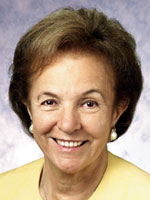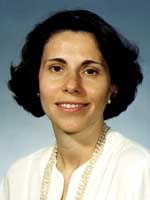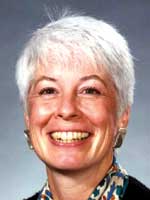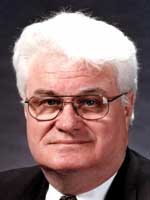Meet The Regents
New York's Education Policy Makers
Compiled by Marie Holmes
If you have visited a museum, attended
school or seen a doctor or other medical professional in
New York State, your experience has been impacted by the
work of the Board of Regents, the policy making body of the
University of the State of New York, the State’s unique
integrated system of education. As the following Board members
can attest, the Regents do much more than mandate high school
examinations.
 Harry Phillips,
3rd, who also serves as Managing Director of financial
services group Winged Keel in New York City, was appointed
in March, 2000. He has served on the board of various non-profit
organizations, including Westchester Community College. As
a Regent, he serves on the Higher Education, Professions, VESID
(Vocational and Educational Services for Individuals with Disabilities)
and Audit committees. A current hot topic facing the Higher
Education committee is teacher education programs. The
Professions committee “is trying to make
sure the public is well-served by the 39 licensed professions,” says
Regent Phillips. Professional licenses granted by the State
University of New York (the Regents) include physicians, pharmacists,
midwives, massage therapists, landscapers and shorthand reporters.
The VESID committee deals with Special Education in the entire
state as well as all other services for persons with disabilities.
The Audit committee, which performs audits of particular districts
and programs, “is concerned with budget imbalances in
the school districts,” according to Phillips.
Harry Phillips,
3rd, who also serves as Managing Director of financial
services group Winged Keel in New York City, was appointed
in March, 2000. He has served on the board of various non-profit
organizations, including Westchester Community College. As
a Regent, he serves on the Higher Education, Professions, VESID
(Vocational and Educational Services for Individuals with Disabilities)
and Audit committees. A current hot topic facing the Higher
Education committee is teacher education programs. The
Professions committee “is trying to make
sure the public is well-served by the 39 licensed professions,” says
Regent Phillips. Professional licenses granted by the State
University of New York (the Regents) include physicians, pharmacists,
midwives, massage therapists, landscapers and shorthand reporters.
The VESID committee deals with Special Education in the entire
state as well as all other services for persons with disabilities.
The Audit committee, which performs audits of particular districts
and programs, “is concerned with budget imbalances in
the school districts,” according to Phillips.
He believes that some of the more
pressing issues now facing the Regents are: dropout rates,
especially in urban areas, test requirements for earning
a high school diploma, and financing VESID efforts and the
testing required by all states under President Bush’s
2001 No Child Left Behind legislation.
The most significant action that
the Board has taken during his tenure, says Phillips, “was the adoption of new standards
that energized the education system in New York State.” In
recent years, the Regents diploma, which high-achieving students
obtained by passing a number of Regents exams, has been phased
out. All high school students in the state will now have to
pass five Regents exams in core curriculum areas to earn a
diploma in 2003.
“The potential of having all institutions that are allied
to education under one body, like the Regents, is staggering.
We need to exploit the connections better,” says Phillips. “If
we can be more flexible on testing, I see a bright future for
the Regents.”
 Charlotte Frank ended her term as Regent
in April, 2002. She came to the Board after having been a
teacher, supervisor and then administrator in the New York
City schools, serving for 25 years as executive director of
curriculum and instruction. She is currently a Senior VP at
McGraw-Hill Publishers and works with the education division.
Charlotte Frank ended her term as Regent
in April, 2002. She came to the Board after having been a
teacher, supervisor and then administrator in the New York
City schools, serving for 25 years as executive director of
curriculum and instruction. She is currently a Senior VP at
McGraw-Hill Publishers and works with the education division.
During her tenure, she served on
the committee that set the new standards for career and technical
education diplomas. Frank praises the flexibility of these
specialized courses of study and says that career and technical
education programs help students see the connections between
academic subjects and career and technical issues, or everyday
life. She was also with the Regents when they raised the
bar for high school students across the state, changing policy
so that all students must pass multiple Regents exams in
order to earn their diplomas. Like many of her colleagues,
she credits the standards movement with saving some students
from others’ low expectations. “The
data was that there were more Special Ed kids passing Regents
exams than had been taking them before.”
The Regents take their duties and
responsibilities seriously, says Frank. They “do a good job of moving around the
state so that they can think about the policies that are designed
and developed.” The concerns of students and schools
in poor areas of the Bronx, for example, aren’t quite
the same as those of students in upstate towns that have struggled
economically since industry left the area. One Superintendent
in an upstate area with plenty of farmland mentioned to the
Regents that his parents worried about their children going
off to college because they were afraid that they would leave
the farm and never come back.
“The dreams are the same, but the issues are very different
. . . Everybody wants their kids to be healthy, responsible,
happy people,” says Frank, noting that New York has traditionally
been a gateway for people looking to fulfill their dreams in
the United States.
The newly-required exams, she says,
test for “skills
that are needed to build up the city, state and nation,” so
that New York does not need to look outside its borders for
a competent workforce.
The mission of the Board of Regents,
says Frank, relates to “the
quality of life in the state.”
 Geraldine Chapey was appointed to
the Board of Regents four years ago, following a long and
varied career in education. She began as an elementary
school teacher and continued to earn licenses and degrees,
including certifications in speech pathology and administration
and a doctorate in administration and public policy from Fordham
University. She was a professor and a dean at St. John’s University and has authored
numerous articles, books and curriculum and currently teaches
at City College. In sum, says Chapey, “I’m steeped
in education—it’s my life.”
Geraldine Chapey was appointed to
the Board of Regents four years ago, following a long and
varied career in education. She began as an elementary
school teacher and continued to earn licenses and degrees,
including certifications in speech pathology and administration
and a doctorate in administration and public policy from Fordham
University. She was a professor and a dean at St. John’s University and has authored
numerous articles, books and curriculum and currently teaches
at City College. In sum, says Chapey, “I’m steeped
in education—it’s my life.”
Regent Chapey serves on the Finance,
Higher Education and VESID committees. She characterizes
the Regents as “policy
makers and accountability assessors,” who work in close
collaboration with those who implement their policies: the
state, federal and local governments. “For our work to
be successful it’s not limited to a group of Regents
sitting in a room making decisions.”
The standards movement penetrates
every level of education, Chapey says, from pre-kindergarten
through graduate school and professional certifications.
The Board is currently working on revising the requirements
to earn certification for leadership positions, such as principals
and superintendents, within the state’s school systems.
These new regulations will then force graduate programs that
prepare such professionals to be reevaluated, as they will
eventually have to re-register with the State Education Department.
Since Chapey joined the Board, the
Regents have toughened the standards for teacher education,
forcing colleges and universities to reregister their teacher
education programs. College presidents became responsible
for oversight of such programs, and “came
by dozens to Regents meetings,” according to Chapey.
Projects in development include a student information system
that would allow school officials to track students within
the state system, to use when students have transferred or
moved.
“What we have been doing is forerunner to a lot of what
the national government is expecting,” says Chapey, claiming
that New York has held the highest education standards in the
entire country since 1984, which she attributes to its unique
immigration patterns and new immigrants’ dependence on
public education.
 Robert M. Bennett, Chancellor of the New
York State Board of Regents, was first appointed in 1995 and
again in 2000. Since 1975, he has taught at the graduate level
both at Niagara University and SUNY Buffalo. He is the founder
of Family Support Centers, which places health and social services
in schools, and Success by Six, an early childhood education
program, both in Western New York.
Robert M. Bennett, Chancellor of the New
York State Board of Regents, was first appointed in 1995 and
again in 2000. Since 1975, he has taught at the graduate level
both at Niagara University and SUNY Buffalo. He is the founder
of Family Support Centers, which places health and social services
in schools, and Success by Six, an early childhood education
program, both in Western New York.
Key educational issues in New York
today, as presented in the Regents’ “performance Agreement” for
Commissioner of Education Robert P. Mills, include: implementing
policies, such as a statewide student record system, that will
help more students meet testing benchmarks, helping school
districts that are struggling with finances and poor student
performance, and strengthening the internal governance of the
Regents and the Department of Education.
The Board is currently reviewing
the standards for school principals. School leaders, says
Bennett, must “understand
governance issues, poverty’s impact and the nature of
families.”
Some of the important policies that the Regents have drafted
during his tenure, Bennett says, include: career and technical
education options, universal pre-kindergarten, teacher preparation
and continuing education requirements, inclusion for special
education students, graduation requirements, the New Centuries
Libraries proposal and the nursing shortage study and subsequent
recommendations.
Regent Bennett believes that the
unique structure of the University of the State of New York,
singular among U.S. institutions and governing bodies, “has the greatest potential to
provide a comprehensive array of education and training services
to all seeking educational opportunities.” In line with
the Regents’ mission to “raise the level of learning
for all New Yorkers,” Bennett would like to see “greater
focus on high need districts, including more effective partnerships
with related State agencies such as Health, Mental Health,
Children and Families.” Another goal is to “have
all children reading at grade level by third grade, thereby
eliminating all level ones on the fourth grade ELA” (English
Language Assesment).”
 James Dawson was appointed
to the Board of Regents in 1993 and was reappointed in 2000.
He serves as a Distinguished Service Professor in the Center
for Earth and Environmental Science, State University of New
York, College at Plattsburgh. Dawson has taught earth science
majors, geology majors, environmental science majors, and general
education undergraduate courses every year since he joined
the faculty as an Assistant Professor on September in 1970.
As a Regent he represents the Fourth Judicial District of New
York State which includes Washington, Schenectady, Montgomery,
Fulton, Hamilton, St. Lawrence, Franklin, Clinton, Essex, Warren
and Saratoga counties. These counties constitute about 29 percent
of the land surface area of the State of New York with districts
ranging from under 20 to about 9,000 students. Dawson has visited
virtually all of these districts and school
James Dawson was appointed
to the Board of Regents in 1993 and was reappointed in 2000.
He serves as a Distinguished Service Professor in the Center
for Earth and Environmental Science, State University of New
York, College at Plattsburgh. Dawson has taught earth science
majors, geology majors, environmental science majors, and general
education undergraduate courses every year since he joined
the faculty as an Assistant Professor on September in 1970.
As a Regent he represents the Fourth Judicial District of New
York State which includes Washington, Schenectady, Montgomery,
Fulton, Hamilton, St. Lawrence, Franklin, Clinton, Essex, Warren
and Saratoga counties. These counties constitute about 29 percent
of the land surface area of the State of New York with districts
ranging from under 20 to about 9,000 students. Dawson has visited
virtually all of these districts and school
buildings.
Regent Dawson currently chairs the
Regents State Aid Subcommittee, which works with the staff
of the State Aid Work Group in the New York State Education
Department to formulate a recommendation on the Regents’ state aid to school districts for the
Regents’ consideration. After the Regents’ have
decided on a proposal (usually at their December meeting) members
of the Subcommittee assist the Commissioner and the Department
in informing the Division of the Budget and the Legislature
about the details of the proposal. In addition, Regent Dawson
serves on the Professional Practice Committee, and the Elementary/Middle/Secondary/Continuing
Education Committee.
One of the most important issues
now facing the Regents, says Dawson, is maintaining adequate
funding for school districts as the state economy sputters. “Funding for library systems
is also a major concern of our Twenty First Century Libraries
proposal,” says Dawson, “and with this year’s
serious budget problems, maintaining the existing levels of
funding for libraries will also be a priority.”
The fact that the Regents have multiple
responsibilities gives them “the capacity to better integrate the policy work
of the Board across all of the educational policy arenas in
the State,” says Dawson. The Regents’ authority,
while spread across a number of areas—K-12, colleges
and universities, professional licensing, museums, libraries
and other cultural institutions—varies significantly
from one area to the next. “Regents’ authority
is clearest and most sweeping in the K-12 arena,” says
Dawson, while more limited in other spheres. “However,” he
adds, “the Regents have had great success with their
existing authority because they are able to use what they have
to gain the voluntary participation of many of the players
across the full range of education arenas.”
 Merryl Tisch was appointed to the Board in 1996. Tisch, who holds a M.A.
in Education from NYU and is currently working towards her
doctoral degree at Columbia University Teachers College,
has focused on education for her entire career, having taught
first grade, worked in the Jewish yeshiva system and served
as president of a not-for-profit organization.
Merryl Tisch was appointed to the Board in 1996. Tisch, who holds a M.A.
in Education from NYU and is currently working towards her
doctoral degree at Columbia University Teachers College,
has focused on education for her entire career, having taught
first grade, worked in the Jewish yeshiva system and served
as president of a not-for-profit organization.
Regent Tisch is chair of the VESID committee and serves on
the State Aid committee, which makes recommendations to the
legislature about how much aid to give to school districts,
the Cultural Education committee, which deals with museums,
libraries and other cultural institutions, and the Quality
committee, which oversees the internal governing of the Board
of Regents.
“New York Sate is probably one of the most segregated
states when it comes to providing services for children with
disabilities within the school system,” says Tisch, adding
that the inclusion movement has taken a hold in the state and
that she expects more progress to be made within the coming
years. When the Board of Regents raised the testing requirements
for high school graduates, “we decided [students with
disabilities] should be incorporated into this movement of
higher standards,” says Tisch, “and, actually,
many of them are performing very well.” For lower-functioning
children who may have more severe disabilities, the state has
put into place an alternative assessment. Students with disabilities,
she affirms, are now receiving the same diplomas that they
would have before the policy changed. If they score a certain
level on competency tests but are unable to pass the Regents
exams, “they get their special ed diploma.” The
real draw of including special education students in testing
practices as well as general education classrooms, says Tisch,
is having “people start to talk about their students’ outcomes
rather than whether we’re complying with standards.”
The Regents, says Tisch, “are a unique group and a group
that ten years ago was tinkering on the verge of irrelevance,” she
says, adding that between then and now, the Regents “really
became a force for change.” These days there is less
anger directed at the Regents. On the other hand, “I
think some people have a harder time with us because we’re
not irrelevant,” she adds. “What they’re
seeing now is that we are very purposeful about the standards
and very thoughtful about the standards.”
 Diane O’Neill McGivern is the first nurse to have been
appointed to the Board of Regents. She was originally recruited
in 1991 to serve the remainder of Dr. Jerry Lustig’s
seven year term, and has since been twice re-elected. For
the past thirty years, Regent McGivern has worked in higher
education both as a professor and an academic administrator.
Diane O’Neill McGivern is the first nurse to have been
appointed to the Board of Regents. She was originally recruited
in 1991 to serve the remainder of Dr. Jerry Lustig’s
seven year term, and has since been twice re-elected. For
the past thirty years, Regent McGivern has worked in higher
education both as a professor and an academic administrator.
McGivern is Chair of the Professional
Practice committee and Vice-President of the Higher Education
committee. The focus of the Professional Practice committee,
says McGivern, “is
to ensure that New York State citizens have the highest quality,
ethical practitioners in a wide range if disciplines.” The
committee takes disciplinary action against individual practitioners,
communicates with the field and anticipates issues of concern.
Some of her past efforts with the Board include having chaired
a Blue Ribbon Panel on the future of nursing in the state,
which examined the nursing shortage.
McGivern has also chaired task forces
on teaching and leadership. The work of her leadership group
has grown into recommendations currently being formulated
by the Board regarding certification requirements for principals
and school administrators. Many people have offered advice
about what the Regents and other groups can do “to attract, cultivate and retain good
leaders,” says McGivern. “Clearly, recognizing
good leaders and supporting them in professional environments
is central to improving instruction for students.”
While there are numerous other issues
that the Board is currently examining, and “as important as the individual policies
are,” McGivern says, “I believe the interconnectedness
of our policies is most significant. The relationship of all
parts of the University of the State of New York is reflected
in policies that link areas like libraries and information
technology to curriculum, services to individuals with disabilities
and access to higher education.”
 James R. Tallon,
Jr., was elected
by the State Legislature last March to serve a five year
term on the Board of Regents. “I’m
one of the new kids,” he jokes. While Tallon might
be new to the Board and to the world of educational policy,
he brings with him years of administrative and political
experience. Tallon currently serves as President of the United
Hospital Fund, a philanthropic and health services research
organization. From 1975 to 1993 he was a member of the New
York State Assembly.
James R. Tallon,
Jr., was elected
by the State Legislature last March to serve a five year
term on the Board of Regents. “I’m
one of the new kids,” he jokes. While Tallon might
be new to the Board and to the world of educational policy,
he brings with him years of administrative and political
experience. Tallon currently serves as President of the United
Hospital Fund, a philanthropic and health services research
organization. From 1975 to 1993 he was a member of the New
York State Assembly.
Regent Tallon serves on the Elementary,
Middle, Secondary and Continuing Education Committee, the
VESID committee, the Cultural Education committee and the
sub-committee on State Aid. Each year, Tallon explains, the
Regents draft a proposal regarding how much money the state
should allocate for the schools and how such funds should
be distributed. A number of concerns arise during this process,
as might be expected in any equation involving billions of
dollars. Like many New Yorkers, Tallon believes that the
state financing system needs to be reformed. At the same
time, the State Aid committee tries to formulate regulations
that are viable in the long term as well as consistent from
one year to the next—a delicate
balance.
Regent Tallon is optimistic when
it comes to New York’s
progress on educational reform. He believes that New York is
further along than many other states when it comes to complying
with the No Child Left Behind regulations, as some New York
laws were basically precursors to the more recent federal legislation.
The State is also on the right path when it comes to special
education, according to Tallon. “I think it’s fair
to say that New York is one of the more aggressive states” concerning
the provision of services for special needs students, he says,
noting that the number of special education students earning
diplomas has increased in recent years.
The Regents, Tallon asserts, are a diverse group, both geographically
and in terms of professional experience. Tallon hopes to use
his own background in State government to help the Regents
better understand the Legislature, and vice versa. He would
also like to examine ways that health and educational services
might be better linked in areas such as early childhood and
adolescent development, nutrition and behavioral and psychological
issues.
“It’s clear that the future of the state and city’s
economy . . . is just anchored in educational achievement,” says
Tallon. The predominantly socio-economically determined gaps
in the educational system, he says, must not be tolerated. “There’s
a societal imperative to just keep advancing this educational
agenda.”
 Judith Rubin was appointed to the Board
in March, 2002. She is Chairman of the Board of Playwrights
Horizons, a not-for-profit off-Broadway theater that works
with undergraduate theater students at NYU and provides paid
internships for young people interested in careers in the arts.
Rubin herself has spent most of her career at various arts-related
organizations. She has been a Council member of the National
Endowment for the Arts and the New York State Council on the
Arts, President of the 92nd Street Y, and Vice-President of
Theatre Communications Group and Public Radio International.
Judith Rubin was appointed to the Board
in March, 2002. She is Chairman of the Board of Playwrights
Horizons, a not-for-profit off-Broadway theater that works
with undergraduate theater students at NYU and provides paid
internships for young people interested in careers in the arts.
Rubin herself has spent most of her career at various arts-related
organizations. She has been a Council member of the National
Endowment for the Arts and the New York State Council on the
Arts, President of the 92nd Street Y, and Vice-President of
Theatre Communications Group and Public Radio International.
Regent Rubin serves on the Elementary, Middle, Secondary and
Continuing Education committee, as well as the Cultural Education,
Quality and Audits committees.#
